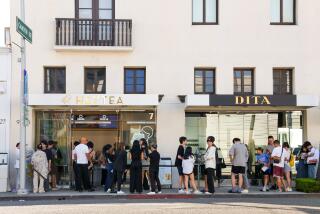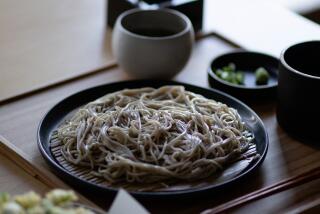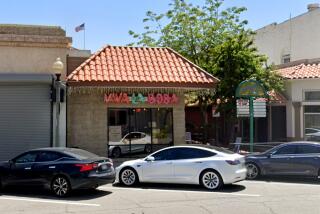Boba Boom
I had my first boba last year at an Islamic Chinese restaurant in San Gabriel, though I was introduced to the drink by another name. “They have this cool lumpy tea,” my friend Kristina said. “I’m totally crazy for it.” Sounds delicious, I thought, noticing the place also served lamb Jell-O. There was no spoiled-brat-Starbucks menu of options here. It was Tea: Yes or No. I said, “Yes,” mostly because I wanted to see them fire up the giant hula doll that doubled as a blender. Holding a silver cocktail shaker in her hands, the doll had a spasm every time someone pushed her button. The cold, weak tea mixed with sweetened milk arrived in a large, clear plastic cup with a fat straw. A cluster of dark, gelatinous tapioca balls floated at the bottom. After a couple of sips, during which I sucked down a slippery lump or two, I began to feel that the doll was the best part of the experience.
I’ve yet to find another boba-making process that is as wildly compelling as hula-baby, but I have discovered much tastier boba. The beverage, which originated more than 10 years ago in Taiwan, is now bubbling up all over Los Angeles, especially in Westwood Village, where I counted at least a half-dozen boba bars, including Lucky Buddha, Relaxtation and Boba World. Even the Espresso Roma Cafe chain is starting to sell boba--also known as black pearl tea, bubble tea, pearl milk tea and zhen zhou nai cha.
And the choices are overwhelming: ice-blended fruit juice flavored with taro or lychee; black tea with a shot of rose syrup shaken “martini-style” and served on the rocks; iced green tea blended with passion fruit juice. How about some Oreo cookies in your milky tea? Or a black tea latte with herbal Jell-O? (There’s no escaping this Jell-O theme.) The sky’s the limit on the chilled liquid concoctions, but the essence of boba is the boba itself--the “giant’s balls,” the “ball explosion” and, in less polite company, the “big knockers.” Without these chewy round spheres lurking on the bottom of the glass, it’s just another pretty drink.
Therefore, in order to do-it-yourself boba, you must locate two key ingredients: the dark, uncooked tapioca and the fat straws to slurp them up with. Though several boba baristas told me I could find the pearls at “any Asian market,” a thorough search of Koreatown was a bust. Ten Ren’s Tea Company in Chinatown, however, is one-stop shopping. I paid $10 for a four-pound, vacuum-sealed bag of dark tapioca--exactly the kind used at most boba shops--and $2 for a pack of jumbo bubble tea straws. (You can also order bubble tea supplies through their Web site, www.tenren.com.) Down the street at Tak Shing Hong grocery, I found jumbo straws for 79 cents and an 8-ounce package of hard “starch balls” for only 69 cents, but when it came to boiling them, they quickly turned to paste. The fresh vacuum-sealed boba is the way to go, and the cooking process is easy--once you know what you’re doing. This is good, because boba needs to be made fresh daily. In a matter of hours, it can turn sticky on the outside and rock hard on the inside.
Not that I know this from actually eating them. I’m happy to chew on one to check doneness, or to see how many I can get in a straw at once, but I can’t actually bring myself to swallow one. Still, I love the aesthetics of boba, they way they’re like little sunken treasures on a colored sea floor, and sometimes good looks are everything.
Boba
1 cup dark tapioca pearls
8 cups water sugar
6 ounces black or green tea
2 ounces raspberry-peach juice
Ice
1 fat straw
*
Gently add tapioca pearls to boiling water, stirring constantly until all pearls float to top, about 30 minutes. Turn off heat and cover tightly for another 30 minutes. Rinse pearls in a colander under cold water to stop cooking process. Transfer to glass bowl and add sugar to taste. In a martini shaker, add ice, tea and juice and shake vigorously. Place
1-2 tablespoons of cooked pearls in a tall, clear glass. Pour tea mixture over balls and garnish with a fat straw.
More to Read
Eat your way across L.A.
Get our weekly Tasting Notes newsletter for reviews, news and more.
You may occasionally receive promotional content from the Los Angeles Times.










